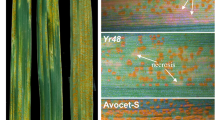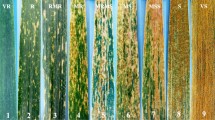Abstract
Studies on natural plant variability for biotic (e.g. disease) and abiotic (e.g. drought) stress resistance/tolerance may provide valuable insights into the use of wild genetic resources for breeding purposes, as such phenotypes are often the product of local adaption. To elucidate the mechanisms underlying stripe rust resistance in wild wheat Aegilops tauschii Coss., the D genome progenitor of common wheat (Triticum aestivum L., AABBDD genome), we studied the distribution of stripe rust resistant accessions among the intraspecific lineages that were found previously through DNA polymorphism analysis (TauL1, TauL2, and TauL3) and the expression of resistance in synthetic allohexaploid lines (AABBDD genome) derived from an artificial cross between Ae. tauschii and a cultivar of Triticum turgidum L., the AB genome progenitor of common wheat. Forty-two, out of the 104 Ae. tauschii representative accessions, showed resistance in a field test. The resistant accessions were from Armenia, Azerbaijan, Iran, and Turkmenistan, and belonged to TauL1 (five accessions) and TauL2 (37 accessions). Most TauL1 and TauL2 accessions parental to the synthetic lines showed resistance in the seedling inoculation tests. Thus, TauL1 and TauL2 lineages may be sources of stripe rust resistance for common wheat improvement. In contrast, virtually all synthetic lines examined (32 lines in total), including 22 lines derived from the resistant TauL2 accessions, were susceptible under field conditions, indicating that field resistance of Ae. tauschii to stripe rust may not be inherited in the synthetic offspring. Seedling inoculation tests showed that the synthetic lines are mostly susceptible, but five had weak resistance.



Similar content being viewed by others
References
Assefa S, Fehrmann H (2000) Resistance to wheat leaf rust in Aegilops tauschii Coss. and inheritance of resistance in hexaploid wheat. Genet Resour Crop Evol 47:135–140. https://doi.org/10.1023/A:1008770226330
Assefa S, Fehrmann H (2004) Evaluation of Aegilops tauschii Coss. for resistance to wheat stem rust and inheritance of resistance genes in hexaploid wheat. Genet Resour Crop Evol 51:663–669. https://doi.org/10.1023/B:GRES.0000024657.20898.ed
Chen W, Liu T, Gao L (2013) Suppression of stripe rust and leaf rust resistances in interspecific crosses of wheat. Euphytica 192:339–346. https://doi.org/10.1007/s10681-012-0854-2
Fox J (2005) The R commander: a basic statistics graphical user interface to R. J Stat Softw 14:1–42. https://doi.org/10.18637/jss.v014.i09
Gogniashvili M, Jinjikhadze T, Maisaia I, Akhalkatsi M, Kotorashvili A, Kotaria N, Beridze T, Dudnikov AJ (2016) Complete chloroplast genomes of Aegilops tauschii Coss. and Ae. cylindrica Host sheds light on plasmon D evolution. Curr Genet 62:791–798. https://doi.org/10.1007/s00294-016-0583-5
Gorafi Y, Kim J-S, Elbashir A, Tsujimoto H (2018) A population of wheat multiple synthetic derivatives: an effective platform to explore, harness and utilize genetic diversity of Aegilops tauschii for wheat improvement. Theor Appl Genet 8:1615–1626. https://doi.org/10.1007/s00122-018-3102-x
Hijmans RJ, Guarino L, Cruz M, Rojas E (2001) Computer tools for spatial analysis of plant genetic resources data: 1. DIVA-GIS. Plant Genet Resour Newsl 127:15–19
Huang L, Zhang L-Q, Liu B-L, Yan Z-H, Zhang B, Zhang H-G, Zheng Y-L, Liu D-C (2011) Molecular tagging of a stripe rust resistance gene in Aegilops tauschii. Euphytica 179:313–318. https://doi.org/10.1007/s10681-010-0330-9
Huerta-Espino J, Singh RP (2017) First detection of virulence in Puccinia striiformis f. sp. tritici to wheat resistance genes Yr10 and Yr24 (= Yr26) in Mexico. Plant Dis 101:1676. https://doi.org/10.1094/PDIS-04-17-0532-PDN
Kihara H (1944) Discovery of the DD-analyser, one of the ancestors of Triticum vulgare. Agric Hortic 19:889–890 (in Japanese)
Kihara H (1946) Maturation division in F1 hybrids between Triticum dicoccoides × Aegilops squarrosa. La Kromosoma 1:6–11 (in Japanese with English summary)
Kilian B, Mammen K, Millet E, Sharma R, Graner A, Salamini F, Hammer K, Özkan H (2011) Aegilops. In: Kole C (ed) Wild crop relatives: genomic and breeding resources, cereals. Springer, Berlin, pp 1–76
Lan C, Zhang Y, Herrera-Foessel SA, Basnet BR, Huerta-Espino J, Lagudah ES, Singh RP (2015) Identification and characterization of pleiotropic and co-located resistance loci to leaf rust and stripe rust in bread wheat cultivar Sujata. Theor Appl Genet 128:549–561. https://doi.org/10.1007/s00122-015-2454-8
Liu D, Zhang L, Yan Z, Lan X, Zheng Y (2010) Stripe rust resistance in Aegilops tauschii and its genetic analysis. Genet Resour Crop Evol 57:325–328. https://doi.org/10.1007/s10722-009-9510-7
Liu M, Zhang C, Yuan C, Zhang L, Huang L, Wu J, Wang J, Zheng Y, Zhang H, Liu D, Fu D (2013) Stripe rust resistance in Aegilops tauschii germplasm. Crop Sci 53:2014–2020
Ma H, Singh RP, Mujeeb-Kazi A (1995) Resistance to stripe rust in Triticum turgidum, T. tauschii and their synthetic hexaploids. Euphytica 82:117–124. https://doi.org/10.1007/BF00027057
Matsuoka Y, Takumi S (2017) The role of reproductive isolation in allopolyploid speciation patterns: empirical insights from the progenitors of common wheat. Sci Rep 7:16004. https://doi.org/10.1038/s41598-017-15919-z
Matsuoka Y, Takumi S, Kawahara T (2007) Natural variation for fertile triploid F1 hybrid formation in allohexaploid wheat speciation. Theor Appl Genet 115:509–518. https://doi.org/10.1007/s00122-007-0584-3
Matsuoka Y, Takumi S, Kawahara T (2008) Flowering time diversification and dispersal in central Eurasian wild wheat Aegilops tauschii Coss.: genealogical and ecological framework. PLoS ONE 3:e3138. https://doi.org/10.1371/journal.pone.0003138
Matsuoka Y, Nasuda S, Ashida Y, Nitta M, Tsujimoto H, Takumi S, Kawahara T (2013) Genetic basis for spontaneous hybrid genome doubling during allopolyploid speciation of common wheat shown by natural variation analyses of the paternal species. PLoS ONE 8:e68310. https://doi.org/10.1371/journal.pone.0068310
Matsuoka Y, Takumi S, Kawahara T (2015) Intraspecific lineage divergence and its association with reproductive trait change during species range expansion in central Eurasian wild wheat Aegilops tauschii Coss (Poaceae). BMC Evol Biol 15:213. https://doi.org/10.1186/s12862-015-0496-9
McFadden ES, Sears ER (1944) The artificial synthesis of Triticum spelta. Rec Genet Soc Am 13:26–27
McNeal FH, Koebner CF, Smith EP, Tate WS, Russell TS (1971) A uniform system for recording and processing cereal research data. Agricultural Research Service Bulletin 34–121, United States Department of Agriculture, Washington
Mizuno N, Yamazaki M, Matsuoka Y, Kawahara T, Takumi S (2010) Population structure of wild wheat D-genome progenitor Aegilops tauschii Coss.: implications for intraspecific lineage diversification and evolution of common wheat. Mol Ecol 19:999–1013. https://doi.org/10.1111/j.1365-294X.2010.04537.x
R Core Team (2018) R: A language and environment for statistical computing. R Foundation for Statistical Computing, Vienna, Austria. https://www.R-project.org/. Accessed 22 Aug 2018
Reynolds M, Dreccer F, Trethowan R (2007) Drought-adaptive traits derived from wheat wild relatives and landraces. J Exp Bot 58:177–186. https://doi.org/10.1093/jxb/erl250
Saisho D, Takumi S, Matsuoka Y (2016) Salt tolerance during germination and seedling growth of wild wheat Aegilops tauschii and its impact on the species range expansion. Sci Rep 6:38554. https://doi.org/10.1038/srep38554
Singh RP, Nelson JC, Sorrells ME (2000) Mapping Yr28 and other genes for resistance to stripe rust in wheat. Crop Sci 40:1148–1155
Trethowan R, Mujeeb-Kazi A (2008) Novel germplasm resources for improving environmental stress tolerance of hexaploid wheat. Crop Sci 48:1255. https://doi.org/10.2135/cropsci2007.08.0477
Ullstrup A (1972) The impacts of the southern corn leaf blight epidemics of 1970–1971. Ann Rev Phytopathol 10:37–50. https://doi.org/10.1146/annurev.py.10.090172.000345
van Slageren MW (1994) Wild wheats: a monograph of Aegilops L. and Amblyopyrum (Jaub. & Spach) Eig (Poaceae). Wageningen Agricultural University, Wageningen
Wang J, Luo MC, Chen Z, Chen Z, You FM, Wei Y, Zheng Y, Dvorak J (2013) Aegilops tauschii single nucleotide polymorphisms shed light on the origins of wheat D-genome genetic diversity and pinpoint the geographic origin of hexaploid wheat. New Phytol 198:925–937. https://doi.org/10.1111/nph.12164
Wellings CR, Singh RP, Yahyaoui AH, Nazari K, McIntosh RA (2009) The development and application of near-isogenic lines for monitoring cereal rust pathogens. In: McIntosh R (ed) Proceedings oral papers, Borlaug Global Rust Initiative: 2009 Technical Workshop, Sonora, Mexico March 17–20, 2009, pp 77–88
Wickham H (2009) ggplot2: elegant graphics for data analysis. Springer, New York
Yang W-Y, Yen C, Yang J-L, Zheng Y-L, Liu D-C (1998) Evaluation of Aegilops tauschii Coss for resistance to physiological strains CYR30 and CYR31 of wheat stripe rust in China. Genet Resour Crop Evol 45:395–398. https://doi.org/10.1023/A:1008651901159
Yang W-Y, Yu Y, Zhang Y, Hu X-R, Wang Y, Zhou Y-C, Lu B-R (2003) Inheritance and expression of stripe rust resistance in common wheat (Triticum aestivum) transferred from Aegilops tauschii and its utilization. Hereditas 139:49–55. https://doi.org/10.1111/j.1601-5223.2003.01671.x
Yildirim A, Jones SS, Murray TD, Cox TS, Line RF (1995) Resistance to stripe rust and eyespot diseases of wheat in Triticum tauschii. Plant Dis 79:1230–1236
Acknowledgements
This study was supported by the Joint Research Program of Arid Land Research Center, Tottori University (Grant Number 29C2016). We are grateful to Plant Germ-plasm Institute of Kyoto University (with the National BioResource Project - KOMUGI), Institut für Pflanzengenetik und Kulturpflanzenforschung, International Center for Agricultural Research in the Dry Areas, and United States Department of Agriculture for the seeds of Ae. tauschii accessions.
Author information
Authors and Affiliations
Corresponding author
Ethics declarations
Conflict of interest
The authors declare that they have no conflict of interest.
Data availability
All data generated or analyzed during this study are included in this published article.
Additional information
Publisher's Note
Springer Nature remains neutral with regard to jurisdictional claims in published maps and institutional affiliations.
Rights and permissions
About this article
Cite this article
Kishii, M., Huerta, J., Tsujimoto, H. et al. Stripe rust resistance in wild wheat Aegilops tauschii Coss.: genetic structure and inheritance in synthetic allohexaploid Triticum wheat lines. Genet Resour Crop Evol 66, 909–920 (2019). https://doi.org/10.1007/s10722-019-00758-w
Received:
Accepted:
Published:
Issue Date:
DOI: https://doi.org/10.1007/s10722-019-00758-w




